Keywords
Students’ health, sunburn, knowledge, sun exposure, sun protection
Introduction
Adverse effects of solar radiation occupy a large part of international literature. [1] Climatological conditions, and mainly ozone layer depletion, transmit more UVR to skin and eyes, increasing this way the risk for serious health problems, such as skin cancer, cataract, skin disorders, skin aging, etc. [2-4] An alarming fact is that the incidence of malign melanoma cases, perhaps the most aggressive type of cancer, along with other skin cancer types, is increasing in younger ages. [5]
Excessive sun exposure during childhood and adolescence and subsequent solar radiation accumulation, are important risk factors for several conditions and mainly skin cancer. [6] It is also well-known that 50-80% of total solar radiation is accumulated during childhood and adolescence. An important factor for malign melanomas to develop later in adulthood is the incidence of sunburns during childhood and adolescence. [6]
The most important risk factors for melanoma are the following: fair complexion with a large number of moles or dysplastic nevi, intense or repeated sun exposure during childhood and adolescence, family history of skin cancer, and at least one serious sunburn during childhood or adolescence. Characteristically, relative risk increases from 1.5 to 6 in persons which had had sunburn compared to those who had suffered five or more sunburns during childhood or adolescence. [7]
It has also been established that most teenagers do not take measures against solar exposure; in fact, given their desire to tan, they tend to expose themselves for longer hours to the sun without any protective measures. Younger people, influenced by media-promoted beauty standards, think that being tan makes them more attractive. Teenagers can spend more time out of house with no parental supervision, something that allows them to not use sunscreen or stay in the shade. Finally, studies that had taken place in coastal areas have shown that younger people tend to go to the beach from 10.00 a.m. to 16.00 p.m., in other words when the intensity of solar radiation is at its peak, running a high risk of sunburns. [8-10]
Malign Melanoma Incidence
Some countries have higher rates of malign melanoma cases especially in younger ages (<40 years of age), something that has alarmed not only local public health services, but the World Health Organization (WHO) as well. WHO has pointed out since 2004 the repercussions due to melanoma incidence worldwide. [11-12] In countries such as Australia, New Zealand and USA, the incidence of melanoma and other skin cancer types, like squamous cell carcinoma (SCC) and basal cell carcinoma (BCC), has soared in the last years, and melanoma-related mortality has also increased significantly. Studies from Australia have shown that people that have lived there for the first fifteen years of their lives, have a 75% higher risk of melanoma compared to people from other countries, with adolescents being the group at higher risk. [9,13]
• New Zealand, of all OECD countries, shows one of the highest rates of melanoma incidence and melanoma-related mortality. It has been estimated that every year 45.000 – 70.000 new cases of skin cancer are diagnosed. Each year, 300 people die from skin cancer, 230 of them due to melanoma. [14]
• In the USA, on the other hand, during the last two decades, a sharp rise of melanoma incidence and mortality has been recorded. According to the National Cancer Institute (NCI, 1999), almost 40-50% of all Americans up to age 65 will develop some type of skin cancer even once, which translates into over 1.000.000 new cases each year. From 1992 to 1998, melanoma incidence in the US has been increasing at 2.7% per year, skin cancers have also increased, and in 2003 melanoma incidence was at 54.000 cases, while 7.600 people died from it in the same year. [15,16]
• In Europe, almost 26.000 males and 33.300 females are diagnosed each year with melanoma, with 8.300 males and 7.600 females dying from it. Throughout Europe there are differences regarding melanoma incidence. Northern and Western Europe have higher incidence rates, yet mortality rates remain about the same.
• In Greece, few studies about malign melanoma have taken place. Cases that are diagnosed in healthcare institutions are not recorded in a coordinated manner. Nevertheless, from 2000 onwards Greece participates in the ‘Euromelanoma’ campaign, which has lead to new initiatives for educating the public and recording new cases of skin cancer; so far, it has been shown that there is a general increase in skin cancer incidence and a more prominent one in younger ages. [17,18]
Sun protection measures
The WHO has suggested that light-coloured cotton clothes that cover most of the body, hats, sun-glasses, staying in the shade, avoiding exposure around noon and using sunscreen with SPF >15 (over 50 for children), are fundamental sun protection measures. [13]
It has been estimated that 75% of all skin cancers could have been prevented by raising children’s and teenagers’ awareness about sun protection measures. [19,20]
Knowledge, perceptions and behaviours of children and adolescents (that comprise a high risk group because of increased sun exposure) have already been the focus of several studies from various countries. Countries with high rates of melanoma incidence have launched targeted studies and prevention-oriented interventions. Most of those studies have shown that more knowledge entails better attitudes and wiser behaviours.
Consequently, a systematic review of all relevant international and Greek literature regarding adolescents’ knowledge level about sun-related risks and sunburn incidence, will point out the potential and also the necessity for designing and implementing educational interventions at all school levels.
The aim of the present study was to explore: (a) Young (10-20 years of age) students knowledge about sun exposure risks, (b) knowledge regarding sun protection measures, and (c) the effect knowledge can have on sunburn incidence, since it is an important risk factor for developing skin cancer, and mainly malign melanoma, later in life.
Methodology
A complex search for relative international and Greek literature took place, using databases and search engines such as Medline, Cochrane Library, Google Scholar, Scirus and Scopus. Only papers from 2002 until today were included. Those papers were critical reviews, metaanalyses and epidemiological studies on the subject. The following key-words were used: Adolescent health, solar radiation, students, sunscreen use, skin cancer, melanoma, sunburn, knowledge, sun exposure, sun protection, isolated or in various combinations. Only studies written in English, French or Greek were included. Clinical studies were excluded, as well as studies regarding other age groups, younger students, adults, teachers, parents, pediatricians, etc.
Initially, 268 articles were gathered. 52 clinical trials on animals and people and 34 articles with no full text available were excluded. 101 more reviews and 7 articles in languages other than English or French were excluded too. From the remaining 107 papers, 49 were excluded because they were about other age-groups. Finally, 25 relative studies were chosen, and after the final geographic distribution, 15 studies were included (Figure 1).
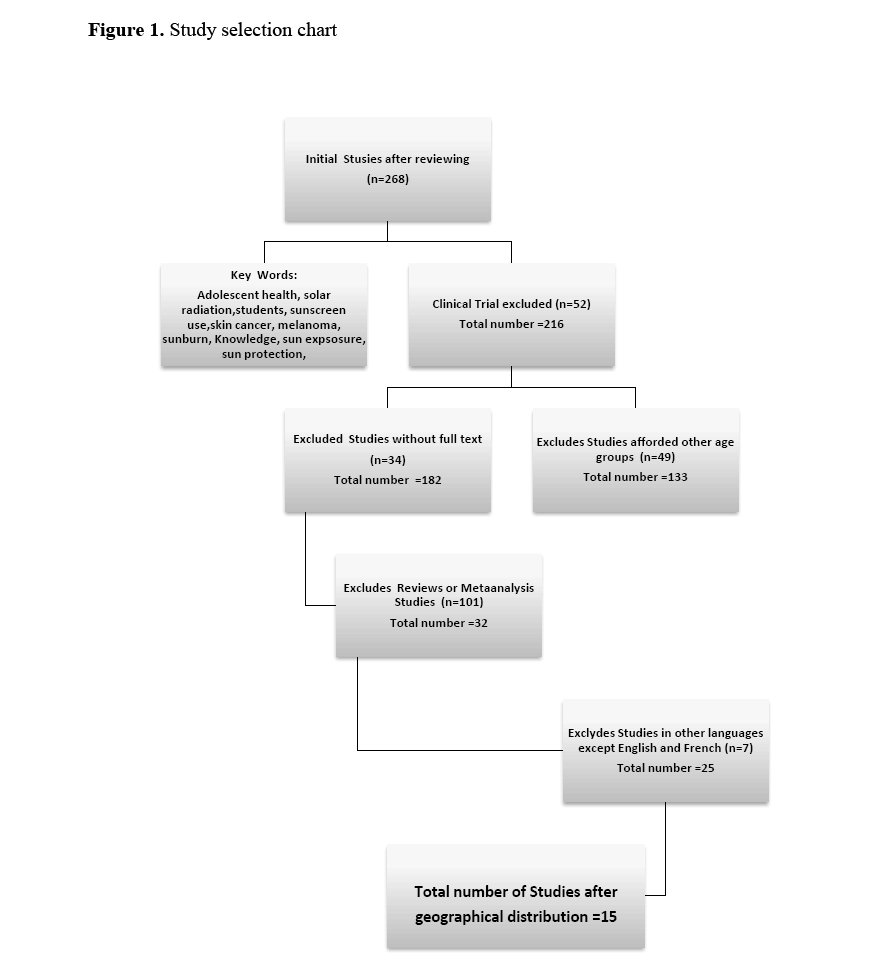
Figure 1: Study selection chart
Detecting the various methods followed by those studies was a difficult task, since those studies had not employed similar tools to record their findings. Nevertheless, the participants’ knowledge level was rather clear, since sun-related risks and sun protection measures have been well-established in the literature. Of course those studies had not examined each and every relevant aspect in a similar manner; consequently, each study’s aims had to be clearly separated.
The decisive factors for including an article in the present study were the following:
• The study population had to be confined to young people ages 9 to 20 years old;
• Only studies that employed anonymous questionnaires could be included;
• The studies had to investigate at least two of the following factors: awareness about the risks of sun exposure, awareness about sun protection measures, sunburn incidence and correlation between knowledge level and sunburn incidence.
Results
In recent years, the number of studies from several countries regarding young people’s knowledge about sun-related risks and sun protection measures has frown rapidly. Assessing young people’s knowledge levels and attitudes can contribute to finding out what knowledge deficits exist and the impact those deficits may have on using protective measures effectively and adopting a wiser behaviour regarding sun exposure. It seems that those studies aim at promoting the development and implementation of related educational interventions.
The present review focuses on major studies from several countries at different latitudes and varying individual characteristics, education level, socioeconomic status, background and culture. Since some countries face a higher incidence of skin cancer, and mainly malign melanoma, such as Australia and the United States, the present review at first focused on numerous studies from those countries that had taken place in an autonomous manner, but most of the time had been used to assess and implement educational interventions. Studies from other countries were also included so that the results could be compared (Table 1).
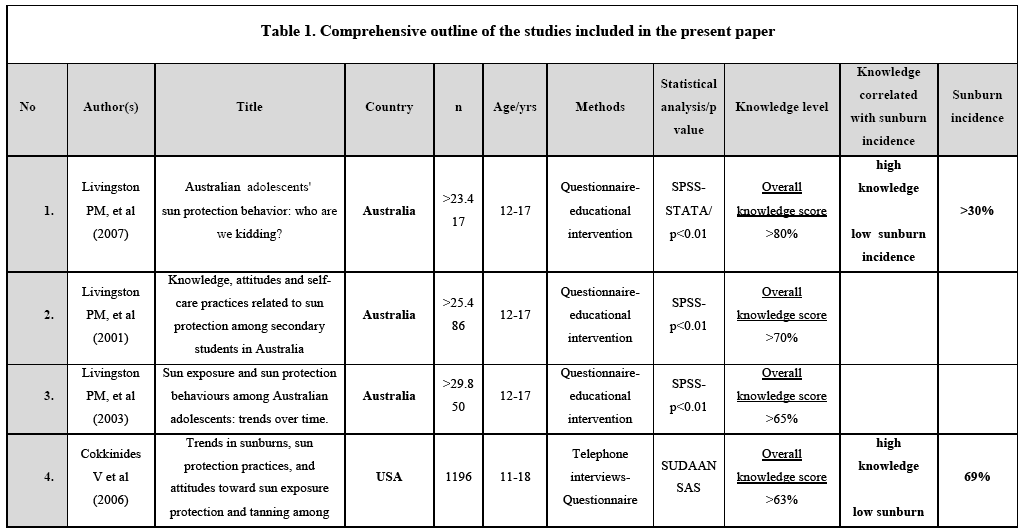
By reviewing four major synchronic studies from Australia, a country with one of the highest melanoma incidence rates worldwide, it becomes clear that there is a continuity between those studies and that here is also a continuous effort to raise public awareness regarding wiser behaviours when it comes to sun protection and young people.
Livingston et al., [21-23] investigated sun-related knowledge and attitudes of young people covering 1996, 1999 and 2002. Their sample consisted of students aged 12 to 17 years old. For each year, more than 20.000 students took part in the study. According to their findings, there was a tendency towards the improvement of knowledge level and attitudes, hence we will compare that review with the most recent one. [23] The participants reported that sunscreen was the most common protection measure, and females preferred tanned skin more than males. Yet, from 1993 to 2002 sunscreen use, especially in males, dropped from 54% to 36%. The participants had high knowledge levels regarding sun protection measures (over 80%), with the percentage steadily rising from 1993 to 1996, but this percentage is in dissonance with compliance to protection measures and sunburn incidence, which was >30% throughout the period of research. Those studies also found a correlation between knowledge level and sunburn incidence, namely that the higher the knowledge levels, the lower the sunburn incidence rates.
In the USA, given that there has been a rise of melanoma incidence in ever-younger age groups, many relevant studies have been taking place. The studies we reviewed show that there is a fluctuation both in knowledge levels and sunburn incidence rates.
Cokkinides et al., [24] published a study which employed telephone interviews of 1.196 adolescents aged 11 to 18 years old from seven different parts of the United States in 1998; a follow-up took place in 2004 including 1.613 adolescents. In 2004, 69% of the participants - and 72% in 1998 - reported at least one sunburn, with females, persons of fair complexion and persons of older age being the group with the highest incidence rates. 47% of those who suffered serious sunburns reported they used to apply sunscreen. It was found that young people have a satisfactory knowledge level regarding sun protection measures (>63%) and the relation between solar radiation and sunburns (>56%). Those levels did not show any improvement in the follow-up study.
Anthony Alberg et al., [25] similarly sought to find out sunburn incidence rates and young people’s attitudes regarding solar radiation. In their study, 2.775 adolescents aged 10 to 16 years old had to answer an anonymous questionnaire. The participants’ knowledge level about sun protection measures was high (>65%), while >36% of the participants said they thought sun protection to be important. 37% of them reported using sunscreen rarely or sporadically, and the incidence rate of at least two sunburns in the past summer was as high as 30%. Sunburn incidence was linked to poor sun protection measures, but it was not found to have any relation to the participants’ knowledge level. Although females outscored males as far as knowledge levels were concerned, sunburn incidence had no statistically significant differentiation among the two genders.
Geller et al., [26] included a sample of 344 students 16.3 years old in average, and an educational intervention was taking place together with the study. After the intervention, it was found that the students’ knowledge level was much higher compared to that prior to the intervention. After the intervention, the adolescents knowledge level reached ~ 60% about sun-related risks (p< 0.0001). Females had had wiser behaviours (88%) compared to males (63%) before and after the intervention, but both genders showed improved knowledge levels (p< 0.05). Incidence rate of at least one sunburn in the summer prior to the study was high for both genders (>34%), but that could not be correlated to the participants’ knowledge levels.
La Bat et al., [27] in their study in Minnesota had a sample of 387 students (out of 1.995) who completed an anonymous questionnaire regarding knowledge and attitudes towards sun protection of 12-18 year-old students. That study was part of an educational intervention that took place in 1995 and was reviewed in 1999. According to the 1999 results, 31% of the participants were aware of the fact that sun exposure may cause skin cancer later in life, and 69% knew that sunscreen can protect the skin. Sunburn incidence was out of the scope of that specific study.
Scholars’ increasing interest in this subject is also evident in Europe-based studies. More specifically:
Yurtseven et al., [28] studied knowledge and attitudes of students aged 18 and older in Turkey. Overall knowledge level of the 18-20 year-old participants (n=198) was found to be 47.8% (p< 0.05), with females outscoring males. 76.7% of them were aware that sunburns are risk factors for skin cancer and 68.7% of them even knew that there is an increased risk if those sunburns occur in childhood or adolescence. There was not any significant correlation between sunburn incidence and gender. The participants’ phototype (IV and V, 56.7% - brown skin) suggests that the participants did not belong to a high-risk group - which is in agreement with the country’s geographical and cultural characteristics. 39.6% of the participants reported at least one sunburn in the summer prior to the study, while 60.4% of them reported none.
In Greece, a study conducted by Saridi et al., [29] with 2.163 elementary school students with an average age of 9.9 (±1.1) years living in a coastal area, attempted to investigate their knowledge level in depth. A standardised questionnaire of 21 items was used in order to investigate the participants’ awareness about sun-related risks and sun protection measures. The students’ average score was as high as (mean±SD) 3.0±0.9 (4 being the maximum). In other words they scored 65% of the total best score. Females outscored by far males (p< 0.001). The phototype of the adolescents who took place in the study (mainly IV and V, brown skin, eyes and hair) is in agreement with the geographical characteristics of the country, since 85% of the participants were Greek. Most of the participants (88.2%) were aware of the fact that solar radiation is much more dangerous between 10 a.m. and 4 p.m., and 94.6% of the students acknowledged that sunscreen protects from sunburns. Also, less than half of the students (41.1%) knew that a sunscreen suitable for children should have SPF value higher than 50, and finally the majority (80%) were aware that frequent and prolonged sun exposure can cause damage to skin and eyes.
In a similar study from Switzerland, Reinau et al., [30] included students of 48 school grades from 13 schools. 960 questionnaires were collected, 41.7% of them were from students 14-17 years old, and the rest from younger students (8-14 years old). The participants were given an explicit definition of sunburn and photypes were used to classify them appropriately. Knowledge score ranged between 0 and 8. As far as prolonged sun exposure and related effects were concerned, knowledge level was 35.7%. Also, 94.6% of the participants were aware that UVR can cause skin cancer, and also 80.5% of them knew that high value SPF sunscreen can offer more protection. Also, 38.4% of the adolescents claimed that they would not mind getting a sunburn in order to get tan. More than 56.3% of them reported at least one sunburn in the past summer. Among them, 29.5% had had a severe yet not painful sunburn, 61.5% had had a painful sunburn, and 7% had had a blistered sunburn. 52.3% of those sunburns occurred while participating in water sports, 19.6% while the individuals were sunbathing, 15.2% during other outdoors activities, and 4.8% during snow skiing. Females had higher risk of sunburn, while no significant difference in sunburn incidence was detected between people with high knowledge level and those with low knowledge level.
In a study from Great Britain, Horsley et al.,31 examined knowledge and behaviour of primary and secondary level students (15-16 years old) and also teachers. 2,692 students from 32 schools participated in the study. The students' knowledge levels varied. 32.9% of them said that the use of sunscreen was important, 21.2% of them said they did not know almost anything about sun protection, a mere 13.8% of them knew that sun exposure may lead to skin cancer, and only 15.8% of them knew that excessive exposure may result in a sunburn. Compared to other studies, in this study a smaller percentage of the participants, 20.7% (n=556), reported a sunburn in the past summer, and 52.5% of them said their skin had peeled. Sunburn incidence was higher in students of fair complexion (22.3% vs 10.6% in students of darker complexion) and most incidents occurred during noon lunch (30.4%), during sports in school (20%), and during swimming at noon (14%). This study also showed that the less information the students had, the higher the sunburn incidence rates (X2=6.971, df=1, p=0.005) were, yet without a clear distinction among primary and secondary level students. 22.9% of the secondary level students who were aware of sun protection measures, reported a sunburn, compared to 19.4% of the students who did not have any knowledge about protection measures and had had a similar sunburn incidence (X2=4.812, df=1, p=0.028).
In a study from Malta, Aquilina et al., [32] 965 students aged 11-14 [range 12.59, 95% CI±0.06] from several junior high schools took part. The most common phototypes were Ι, ΙΙ, ΙΙΙ, in other words the majority were individuals of fair complexion and light-coloured hair and eyes, hence more susceptible to sunburns. 87.7% of them said they were aware of the main risks associated with sun exposure, i.e. sunburns, 86.9% of them knew that melanoma is the most dangerous skin cancer, and 95.8% of them knew that the most dangerous time of the day was between 10.00 a.m. and 16.00 p.m. Nevertheless, those high knowledge levels were not on par with correct behaviour regarding sun exposure, since sunbathing during noon hours was an activity both males and females enjoyed. Finally this study did not concern itself with sunburn incidence rates.
In a study from Sweden by Kristjánsson et al., [33] 6.000 adolescents aged 13-19 years were given a standardised, 64-item questionnaire, which was fully completed by 4.078 of them. Twelve questions were about knowledge levels and their scores ranged between 12 - 60. Females outscored males regarding knowledge about UVR exposure [mean 5.4 (SD 1.7) vs mean 5.1 (SD 1.8), P <0.001]. More than 90% of the participants were aware of the fact that sunburns may lead to skin cancer, and that people are more prone to sunburns during noon hours. 53% of the adolescents did not know what the suitable SPF was, and almost 60% of them reported sunburn in the past summer, while 40% of the participants said they did not use any sunscreen at all.
Individuals with higher knowledge levels did not have lower sunburn incidence (the results were not presented). 82% of those who had higher knowledge levels, also used sunscreen [1.9(1.6-2.1)] (Odds Ratio 95% CI).
In a comparative study from USA and Denmark, Savona et al., [34] sought to compare knowledge levels and attitudes between 1.157 adolescents (aged 13-19) from those two countries by anonymous 20-item questionnaires. According to the study, 69% of Danish students and 59% of their US counterparts are not aware that they may develop skin cancer later in life (p<0.001), while only 23% of the Danish participants and 67% of the American students are aware of the severity of the melanoma. Their capability to spot a possible melanoma had had similar percentages (25% vs 80%) (p<0.001), yet both groups (~70%) knew that sun radiation is very dangerous especially during noon hours (p=NS). Regarding sunburn incidence, both countries have similar results (47%, p=NS), and Americans reported more severe sunburns (59% vs 50%, p= 0.04). In Denmark, males reported higher sunburn incidence compared to females (52% vs 44%, p<0.001), but Americans had no differences among genders.
In a study from Brazil, Dupont et al., [35] a country were sunbathing and sun exposure is quite common even from childhood, 755 junior high-school students took part and had to complete an anonymous questionnaire. Their knowledge level regarding sun-related risks and sun protection measures was as high as 34.6%. The majority of the participants (73%) reported at least one sunburn in the past summer, while 73.7% of them said that they did not tan easily or even at all. Unsurprisingly, individuals of fair complexion had had higher sunburn incidence rates, although, as expected, most native Brazilians do not usually have a fair complexion. This particular study, found high knowledge levels regarding sun-related risks and sun protection measures among adolescents. More specifically, 67.5% (p< 0.001), know what the most unsuitable hours are, yet over 50% of them expose themselves to the sun exactly during those hours (11.00-16.00); also, their knowledge levels did not have any correlation with the amount of time they spend under the sun (p=0.064). 7.9% reported they did not know any of the five main risks (skin cancer, sunburn, heatstroke, sun skin spots, premature skin aging), 42.5% of the students said they knew only two of them, 14.3% reported they knew three of them, and just 3.1% pf the participants were familiar with all five risks. In conclusion, the participating adolescents satisfactory knowledge levels regarding sun-related risks and sun protection measures, yet they expose themselves to the sun for too much time without taking sufficient protection measures, something which leads to higher sunburn incidence rates.
Discussion
Many researchers worldwide have tried to find out what knowledge people aged 9-20 years have regarding sun-related risks and sun protection measures. Of course, attitudes, perceptions and daily behaviour are also of great scientific importance. [13-16] Childhood and adolescence have been the target of many researchers mainly due to the concept of social learning and other theoretical approaches regarding health behaviours that examine beliefs, attitudes and individual values. Children, by observing and learning, shape a part of their behaviour. Family, social environment and school play an important role in this process. It has been suggested that school-age period is the most suitable for interventions to be held in order for wiser perceptions and attitudes to be adopted. [36-38]
Assessing students' knowledge about sun-related risks and sun protection measures can shed light to education deficits that may be linked to those issues, something that could be the foundation for targeted educational interventions that could encourage young people to adopt wiser and healthier behaviours not only for the time being, but for the years to come too. [26,29,39]
It was found that young people have sufficient knowledge about solar radiation and skin cancer, melanoma and how dangerous it can be, and also what the worst time of the day is to expose oneself to the sun (Table 1). [21-26]
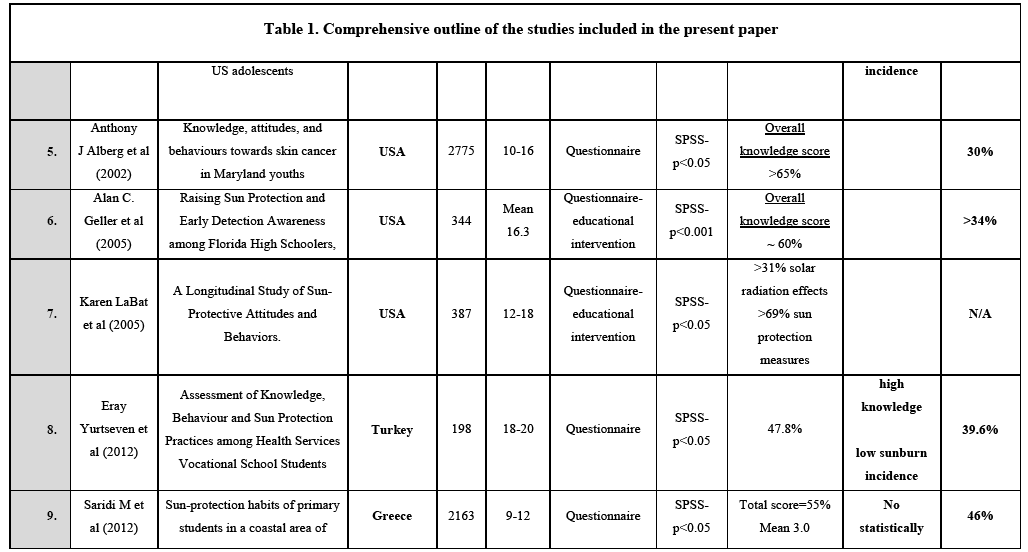
Awareness about sun protection measures and their efficiency varies considerably from study to study (Figure 2). Young people of comparatively older age seem to have better knowledge levels, which is only natural since knowledge is something to be gained and enriched gradually in the course of life [31-34]. There are also some differences according to the countries the studies took place in, something that could be attributed to more educational interventions that have been taking place for years in countries with high melanoma rates, in and out of school [35-38]. Most popular sun protection measures are the use of sunscreen and hats, followed by light-coloured clothing, sunglasses, staying in the shade etc. Overall, USA, Australia, Sweden and Denmark have high knowledge levels, leaving Greece significantly behind especially when it comes to knowledge about melanoma and sun-related skin cancer. [21,25,26,29]
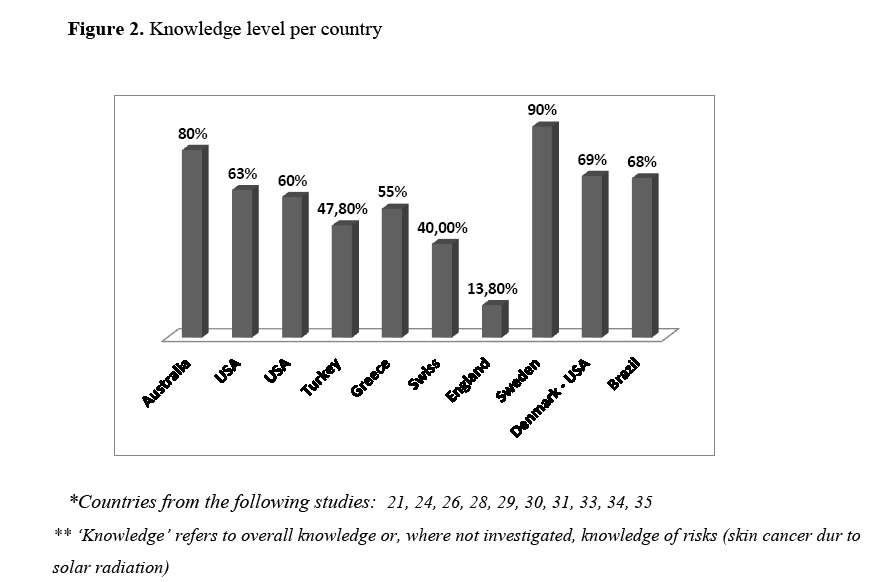
Figure 2: Knowledge level per country
Regarding sunburn incidence, it seems that it is higher in people of older age, and in countries where educational interventions have not been launched yet both in and out of school (Table 1). For instance, Australia and England seem to have the lowest sunburn incidence rates, something that could be attributed to educational programmes and interventions available from pre-school age. [21-23] Other European countries (Figure 3) have higher rates, while in Greece the rate is up to 50% of the study sample [28,30,31].
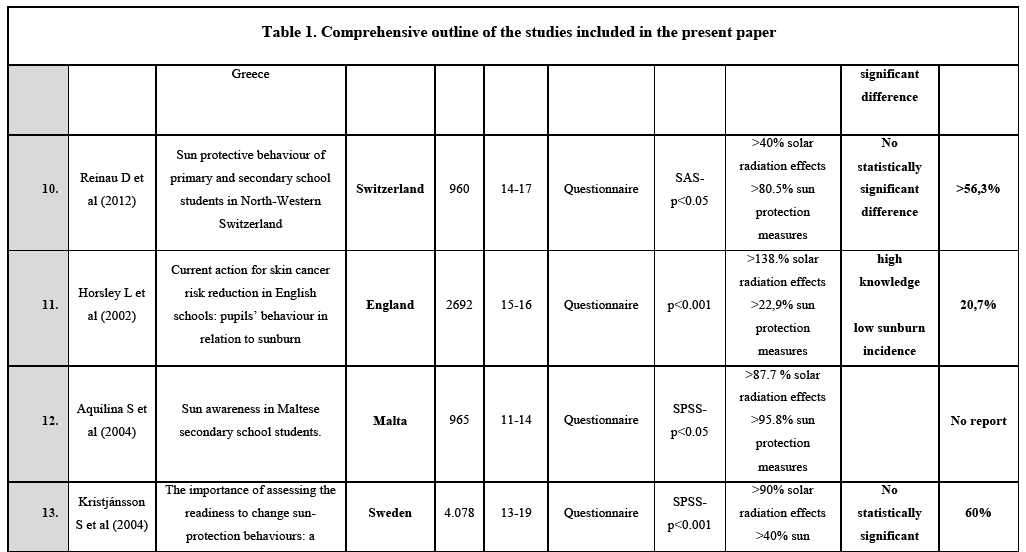
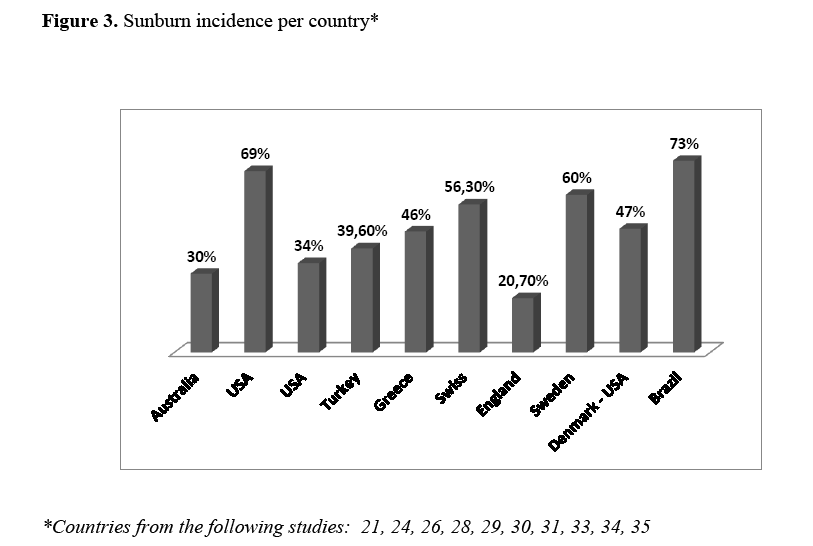
Figure 3: Sunburn incidence per country*
Correlation between knowledge levels and sunburn incidence did not concern all of the studies we reviewed (Table 1). In those cases where that were methodologically feasible, knowledge levels seem to be negatively correlated to sunburn incidence rates. In other words, people with higher knowledge and awareness levels had lower sunburn incidence rates too, something anyway expected. [21] Nevertheless, there were also several studies where not only this correlation did not found, but, paradoxically, although most students had high knowledge levels, yet they also had high sunburn incidence, mainly due to prolonged exposure to the sun in order to tan (Table 1). [29,30,33]
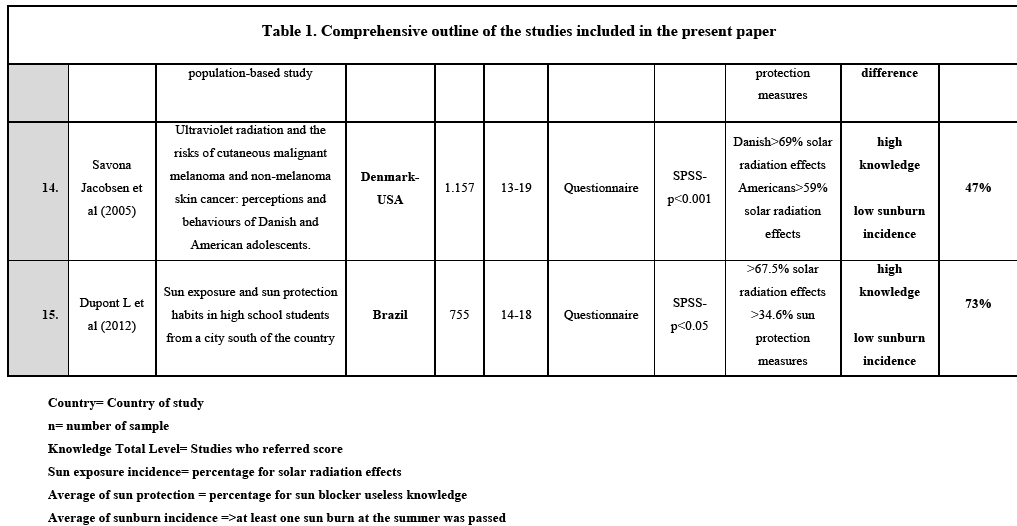
It seems that Media-promoted beauty ideals (tan skin) combined with young people's tendency for outdoors activities and sports (sea sports, swimming, etc) shape their daily activities and preferences. The relevant literature suggests that high knowledge does not go necessarily hand in hand with adopting healthier attitudes and behaviours [31,34,40]. In other words, although quite a few young people are aware of sun-related risks and know about sun protection measures, they still do not adopt a healthier behaviour, resulting in high sunburn incidence rates [24,28,34]. It is also noteworthy that adolescents as a group are generally hard to change and adjust their behaviour and attitudes, so establishing quick and direct behaviour changes can be difficult and time-consuming. [41,42]
Nevertheless, higher awareness and knowledge levels as well as better and healthier sun-related attitudes, could be achieved through targeted educational interventions, that -in the long run- could lead to lower malign melanoma rates [43,44]. Changes in a given population's health behaviour should start from early on, from the early schooling years, should include society in general (family, school, teachers, healthcare institutions, etc) and should be well-coordinated; educational interventions that are isolated, disperse and have no continuity have basically no effect [13,19,43].
2785
References
- Gies PH, Roy CR, Toomey S, McLennan A. Protection against solar UV radiation. Mutat Res 1998; 422(1): 15–22.
- IARC Monograph on the Evaluation of Carcinogenic Risks to Humans. Solar and Ultraviolet Radiation 1992; 55: 95–122.
- Armstrong BK. Stratospheric ozone and health. International Journal of Epidemiology 1994; 23(5): 873–885.
- NASA's Total Ozone Mapping Spectrometer, TOMS 2005. Available at: https://eospso.gsfc.nasa.gov/missions/total-ozone-mapping-spectrometer-earth-probe. [Accessed on May 15, 2010].
- WHO, Global solar UV index, An educational tool to reduce risks of skin cancer and cataract, Fact Sheet 271, 2002.
- Haake AR, Holbrook K. The structure and development of skin.Ch.7,pp 70-114, in Fitzpatrick’s Dermatology in General Medicine, 5th ed., Edited by I. Freedberg et al,Mc Graw-Hil,1999.
- Fitzpatrick T, Richard J, Wolf K, Suurmond D. Clinical Dermatology, (Greek edition), Athens, 2003, pp. 181-275.
- Marks R, McCarthy WH. Skin cancer: increasing incidence and public awareness. Med J 1990; 153:505-506.
- Giles GG, Marks RM, Foley P. Incidence of non-melanocytic skin cancer treated in Australia. Br Med J 1988; 296: 13-17.
- Westerdahl J, Ingvar C, Masbäck A, Jonsson N, Olsson H. Risk of cutaneous malignant melanoma in relation to use of sunbeds: further evidence for UV-A carcinogenicity. Br J Cancer 2000; 82: 1593-9.
- Autler P, Doré J, Lenard F, Luther H. Cattaruzza M, Lefeiler O, et al. Melanoma and sunscreen use: need for studies representative of actual behaviors. MelanomaResearch 1997; 7(3): S115-S120.
- English D, Armstrong B, Kricker A, Winter M, Heenan P, Randell P. Casecontrol study of sun exposure and squamous cell carcinoma of the skin. International Journal of Cancer 1998; 77: 347-53.
- WHO. Sun Protection and schools, How to make a difference, 2003. Available at https://www.who.int/phe/uv [Accessed May 05, 2009].
- CDC. Counseling to prevent skin cancer: recommendations and rationale of the US Preventive Services Task Force. MMWR 2003; 52(No.RR-15):13–17. Available at: https://www.cdc.gov/mmwr/preview/mmwrhtml/rr5215a2.htm. [Accessed March 10, 2010].
- Wang SQ, Balagula Y, Osterwalder U. Photoprotection: a review of the current and future technologies. Dermatol Ther 2010;23(1): 31-47.
- American Cancer Society. Cancer Facts and Figures. Available at: https://www.cancer.org/docroot/stt/content/s tt1xcancerfacts_figures2002.asp. [Accessed March 10, 2010].
- Stratigos JD, Katsambas A,Christofidou E, HasapiV, Katoulis A, Stratigos A, et al. Non-melanoma skin cancer in Greece - A clinico-epidemiological profile, Greece. Skin Cancer 1996; 11(1): 9-17.
- Katsambas A, Nicolaidou E. Cutaneous malignant melanoma and sun exposure. Recent developments in epidemiology. Arch Dermatol 1996; 132(4): 444-50.
- Cancer Society of New Zealand. Sample sun protection policy for primary schools. Wellington: Cancer Society of New Zealand, 2006.
- Wright C, Reeder AI, Gray A, Cox B. Child sun protection: sun-related attitudes mediate the association between children's knowledge and behaviours. J Paediatr Child Health 2008; 44(12): 692-8.
- Livingston PM, White V, Hayman J, Dobbinson S. Australian adolescents' sun protection behavior: who are we kidding? Prev Med 2007; 44(6): 508-12.
- Livingston PM, White VM, Borland R. Knowledge, attitudes and self-care practices related to sun protection among secondary students in Australia. Health Educ Res 2001; 16(3): 269–278.
- Livingston P, White V, Hayman J, Dobbinson S. Sun exposure and sun protection behaviours among Australian adolescents: trends over time. Prev Med 2003; 37: 577–584.
- Cokkinides V, Weinstock M, Glanz K, Albano J, Ward E, Thun M. Trends in sunburns, sun protection practices, and attitudes toward sun exposure protection and tanning among US adolescents, 1998-2004. Pediatrics 2006; 118(3): 853-64.
- Anthony J, Alberg Herbst RM, Genkinger JM, Duszynski KR. Knowledge, attitudes, and behaviours towards skin cancer in Maryland youths. Journal of Adolescent Health 2002; 31: 372-377.
- Geller AC, Shamban J, O’Riordan DL, Slygh C, Kinney JP, Rosenberg S. Raising Sun Protection and Early Detection Awareness among Florida High Schoolers, Pediatric Dermatology 2005; 22(2): 112–118.
- LaBat K, De Long M, Gahring SA. A Longitudinal Study of Sun-Protective Attitudes and Behaviors. Family and Consumer Sciences Research Journal 2005; 33(3): 240-254.
- Yurtseven E, Ulus T, Vehid S, Köksal S, Bosat M, Akkoyun K. Assessment of Knowledge, Behaviour and Sun Protection Practices among Health Services Vocational School Students. Int J Environ Res Public Health 2012; 9(7): 2378–2385.
- Saridi M, Toska A, Rekleiti M, Wozniak G, Liachopoulou A, Kalokairinou A, et al. Sun-protection habits of primary students in a coastal area of Greece. J Skin Cancer 2012; 629652. doi: 10.1155/2012/629652. Epub 2012 Sep 30.
- Reinau D, Meier C, Gerber N, Hofbauer GF, Surber C. Sun protective behaviour of primary and secondary school students in North-Western Switzerland. Swiss Med Wkly 2012;142:w13520. doi: 10.4414/smw.2012.13520.
- Horsley L, Charlton A, Waterman C. Current action for skin cancer risk reduction in English schools: pupils’ behaviour in relation to sunburn. Health education Research, Theory & Practice 2002; 17(6): 715–731.
- Aquilina S, Amato Gauci A, Ellul M, Scerri. L Sun awareness in Maltese secondary school students. JEADV 2004; 18: 670–6.
- Kristjánsson S, Ullén H, Helgason AR. The importance of assessing the readiness to change sun-protection behaviours: a population-based study. Eur J Cancer 2004; 40(18): 2773-80.
- Savona MR, Jacobsen MD, James R, Owen MD. Ultraviolet radiation and the risks of cutaneous malignant melanoma and non-melanoma skin cancer: perceptions and behaviours of Danish and American adolescents. European Journal of Cancer Prevention 2005; 14(1): 57-62.
- Dupont L, Pereira DN. Sun exposure and sun protection habits in high school students from a city south of the country. An Bras Dermatol, 2012; 87(1): 90-5.
- Vries H, de Lezwijn J, Hol M, Honing C. Skin cancer prevention: behaviour and motives of Dutch adolescents, European Journal of Cancer Prevention, 2005 Lippincott Williams & Wilkins, Inc. 2005; 14(1), pp. 39-50.
- Jopson J, Reeder A. Sun Protection in New Zealand Secondary Schools: Obstacles and Opportunities. Department of Preventive and Social Medicine University of Otago Dunedin, NEW ZHLAND June 2004.
- Girgis A, Sanson-Fisher RW, Tripodi DA, Golding T. Evaluation of interventions to improve solar protection in primary schools. Health Educ Q, 1993; 20: 275– 87.
- Mahé E, Beauchet A, de Paula Corrêa M, Godin-Beekmann S, Haeffelin M, Bruant S, Fay-Chatelard F, et al. Outdoor sports and risk of ultraviolet radiation-related skin lesions in children: evaluation of risks and prevention. Br J Dermatol, 2011; 165(2): 360-7.
- Benvenuto-Andrade C, Zen B, Fonseca G, De Villa D, Cestari T. Sun exposure and sun protection habits among high-school adolescents in Porto Alegre, Brazil. Photochem Photobiol, 2005; 81(3): 630-5.
- Stanton WR, Janda M, Baade PD, Anderson P. Primary prevention of skin cancer: a review of sun protection in Australia and internationally. Health Promot Int, 2004; 19(3): 369-78.
- Lowe JB, Borland R, Stanton WR, Baade P, White V, Balanda KP. Sun-safe behavior among secondary school students in Australia. Health Education Research, Theory & Practice, 2000; 15: no.3.
- WHO. Ultraviolet radiation and the INTERSUN Programme. Available at: https://www.who.int/uv/intersunprogramme/en/.[Accessed March 10, 2010].
- Cancer Research UK. Sun smart programme. Sun protection in schools. Available at: https://www.sunsmart.org.uk/schools/.[Accessed March 10, 2010].












